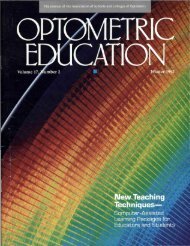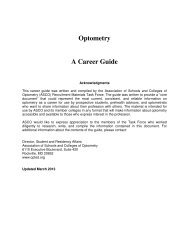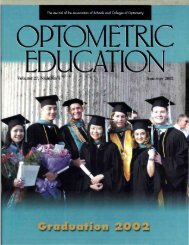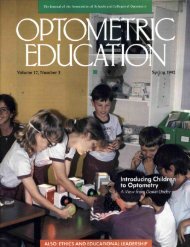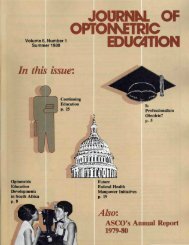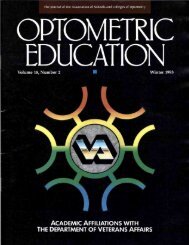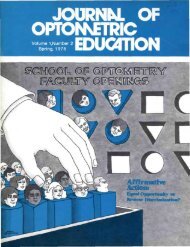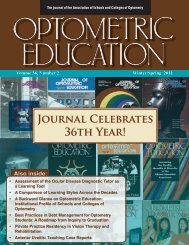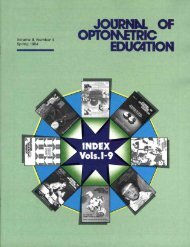Summer 2012, Volume 37, Number 3 - Association of Schools and ...
Summer 2012, Volume 37, Number 3 - Association of Schools and ...
Summer 2012, Volume 37, Number 3 - Association of Schools and ...
Create successful ePaper yourself
Turn your PDF publications into a flip-book with our unique Google optimized e-Paper software.
The model estimates 39,445 clinicianoptometrists<br />
in 2011. The U.S. Census<br />
estimated that in 2010, 16% <strong>of</strong> the<br />
population were Hispanic, 12% were<br />
Non-Hispanic Black, 65% were Non-<br />
Hispanic White, <strong>and</strong> 5% were Asian.<br />
The percentage <strong>of</strong> White <strong>and</strong> Asian optometrists<br />
exceeds their proportions in<br />
the population by 7.3% <strong>and</strong> 11.6%, respectively.<br />
Black <strong>and</strong> Hispanic optometrists<br />
are substantially smaller in proportion<br />
than the population by 9.7% <strong>and</strong><br />
11.3%. The two-proportion z-test for<br />
each category <strong>of</strong> race <strong>and</strong> ethnicity consistently<br />
reveals that the probability <strong>of</strong><br />
finding no difference in proportions is<br />
< .001. (Table 2)<br />
When looking at the race <strong>and</strong> ethnicity<br />
proportions <strong>of</strong> optometry school<br />
graduates compared with those achieving<br />
their first pr<strong>of</strong>essional degrees, 34 the<br />
Hispanic share <strong>of</strong> graduates from optometry<br />
schools is consistent with the<br />
percentage achieving first pr<strong>of</strong>essional<br />
degrees across the nation. For example,<br />
the ratio <strong>of</strong> Hispanic optometry school<br />
graduates to Hispanics attaining first<br />
pr<strong>of</strong>essional degrees is approximately<br />
1:1 over the past 10 years. (Figure<br />
2) Over the same period, that ratio is<br />
closer to 0.5:1 for Blacks <strong>and</strong> 2:1 for<br />
Asians.<br />
Careers in the patient care pr<strong>of</strong>essions<br />
are longer than the average U.S. worker’s,<br />
so the educational pipeline affects<br />
the race <strong>and</strong> ethnicity <strong>of</strong> clinicians for<br />
many decades. 35, 36 When compared<br />
with other healthcare pr<strong>of</strong>essions requiring<br />
at least four years <strong>of</strong> post-baccalaureate<br />
training, optometry seems<br />
to do slightly better than dentistry in<br />
attracting Black individuals, about the<br />
same for Hispanics in dentistry, but not<br />
as well as medicine in attracting Blacks<br />
or Hispanics. (Table 3) Still, the gap<br />
between Black <strong>and</strong> Hispanic clinicians<br />
<strong>and</strong> their proportions in the population<br />
remains large regardless <strong>of</strong> pr<strong>of</strong>ession.<br />
These gaps will persist, as the percent <strong>of</strong><br />
Black <strong>and</strong> Hispanic students enrolled in<br />
U.S. optometry schools has remained<br />
below 5% each, while the percent <strong>of</strong><br />
Asians now exceeds 28%. The Hispanic<br />
population in the United States<br />
is expected to reach 30% in 2050, <strong>and</strong><br />
Non-Hispanic Blacks are anticipated<br />
to remain steady at 12% over the next<br />
40 years. Non-Hispanic Whites are ex-<br />
White<br />
(non-Hispanic)<br />
Black<br />
(non-Hispanic)<br />
Table 2<br />
Estimated <strong>Number</strong>s <strong>of</strong> Optometrists in 2011<br />
Compared with U.S. Census 2010<br />
<strong>Number</strong>s <strong>of</strong><br />
optometrists<br />
2011 (model)<br />
Proportion <strong>of</strong><br />
optometrists<br />
(model)<br />
Population<br />
proportions<br />
(U.S. Census<br />
2010)<br />
Difference in<br />
proportions<br />
between<br />
optometrists<br />
<strong>and</strong><br />
population<br />
Table 3<br />
2011 Proportion <strong>of</strong> Pr<strong>of</strong>essions <strong>and</strong> Population<br />
by Select Race <strong>and</strong> Ethnicity<br />
P – value<br />
(2 proportion<br />
z-Test)<br />
28,434 72.0 64.7 7.3 < .001<br />
983 2.5 12.2 - 9.7



